Gesmatbewertung: 7/10 Detailbewertungen am Ende des Berichts | Vergleich aller Wettkämpfe
When I finished Ottawa Marathon in 3 hours and 12 minutes last year, I was so surprised missing the Boston qualifying standard for my age group by only a little over two minutes that a goal which before seemed impossible to reach suddenly became much more realistic. When planning the 2023 marathon season I wanted to find a race that would turn me into a Boston Qualifier and would also serve for a scenic and unique vacationing destination. The Tunnel Marathon in North Bend, Washington, seemed like the perfect fit. And it turned out it was!
Race and travel
Combining vacation with running events for me and my partner Tara is just the best way to utilize our days off work. Exploring new places while putting our constant marathon training to the test and spending time with likeminded athletes in a running event is something that we’d been doing since last year, when we ran the Nova Scotia Marathon together, followed by Hamilton Marathon a couple months later. This year, I found a gem of a race to try out and for both of us to pursue our BQ attempts: The Light at the End of the Tunnel Marathon in Washington State. A point-to-point course, that starts up in the hills just east of Seattle, and winds from an elevation of around 800 meters down to just under 200. All of which on an old train track, on packed gravel, with no traffic around, hopefully some good views. This marathon’s most unique feature, however, was running through a 4-kilometer-long former railroad tunnel right after the start. Tara was sold instantly, not least because North Bend also hosted one of her all-time favorite 90s T.V. shows called “Twin Peaks”. 2023 vacation was booked for June. I would run 42 kilometers just two days before my 42nd birthday.
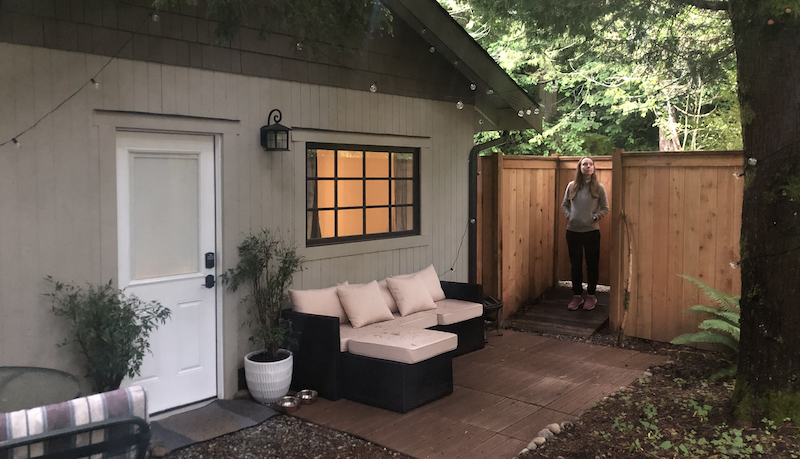
Up the mountain
When races start rather early in the morning and require an hour of driving just to get to the starting line your morning routine will have to start long before sunrise. We got up at 4:00am I believe, just to have enough time preparing, eating, and dealing with our nerves, caused by so many unknowns: How would my legs respond to running downhill for an entire marathon distance? Will I have to deal with sand and gravel in my shoes and socks? How in the world am I going to pace myself in a pitch-black tunnel, that does not allow GPS signal reception for four full kilometers, right at the beginning of the race? How are the trail conditions after 2 days of raining? Would I really be able to run a marathon in these circumstances in under 3h10m? This was my overall marathon number 15, and the second one this year, but all the experience in the world can hardly prepare you well enough for a race that is so different from each one before.

It was still somewhat dark outside when we left the little cabin in the woods that we’d rented, and the air was humid from a day and a night worth of rain. After double-checking all our gear, we got in the car on our way to the starting line. The route took us up into the mountains along Interstate-90 going east, basically paralleling the gravel trail we’d use to run back down into the valley just a couple hours later. The highway was empty that time of day, and the only cars that passed us were clearly occupied by other marathon participants; not too often do you see so many other drivers wearing running gear and hats behind the wheel! When we reached the top, the sun was technically up, but quite some fog and mist turned the scene in the little ski resort village just past Snoqualmie Pass into a bit of a mystic scene and kept the temperatures cool, but not too cold. Parking was no issue even for a field of roughly 800 participants; after all, this is the United States.
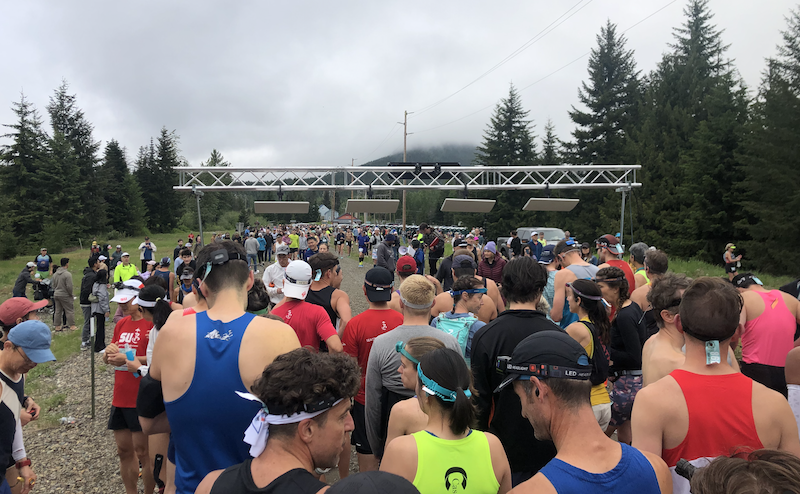
A dark start
Tara and I seeded ourselves in our respective corrals just minutes before the run started at 7 o’clock. And off we went, full of energy and anticipation of a hopefully enjoyable and fast marathon event! It only took a few minutes before the black tunnel entrance opened up just in front of me. It almost felt a bit threatening entering that big, dark gate-like opening in the mountain, a couple meters wide and a couple more high, knowing that it would be at least 17 minutes before I’d see daylight again. It not only was considerably colder in here than outside, it also got pitch black in the matter of just seconds. The tunnel followed a straight line, but with its length of four full kilometers there was no end in sight. Most runners were wearing headlamps. A very special atmosphere indeed. In the dark with no visual references and only being able to see whatever your lamp illuminates in front of you, one’s sense of pace is all over the place. My goal was to run at a consistent 4 minutes and 20 seconds per kilometer but with no GPS signal I wasn’t sure if I could trust my Garmin watch’s gyroscopic pace estimation. The display told me I was right on target, but only after exiting the tunnel and comparing the time with the first mile marker would provide certainty. I was not able to spot any distance signs in the tunnel itself.
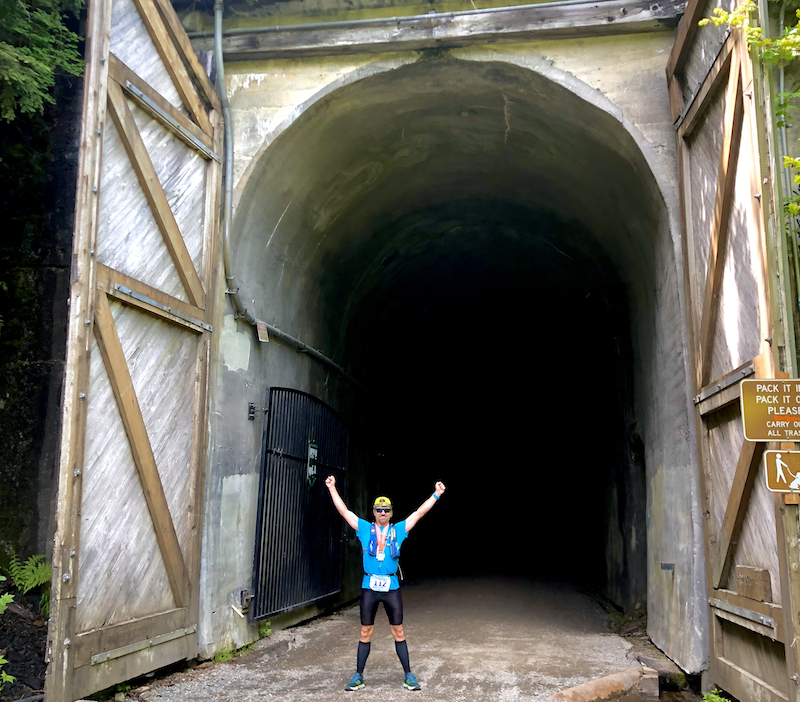
However, it was an unforgettable experience, cruising through this old tunnel along with hundreds of other athletes. Soon enough you’d see a small white point of light in the very distance, but it was impossible to guess how far, and it took another 10 minutes until I reached the exit. A group of volunteers reminded us to turn and take off our headlamps and leaving them behind in one of the buckets they provided along the trail. The weather was not different on this side of the mountain, but after the cold tunnel even 12ºC felt comfortably warm. The fog was still present, too.
Pace check on the other side
Exiting the tunnel, I was most curious about where I was in regard to time and pace. I exited the tunnel in under 18 minutes and knew that this was what I had calculated before. It did not take too long until the GPS signal was back. All I needed now was an official mile marker to compare with my metric measurement on my wrist to know for certain. When I finally passed the 3-mile sign and Garmin showed me just under 5 kilometers it surprised me realizing that pacing through the mountain was in fact spot-on. I was moving at 4m20s per kilometer consistently over the past 22 minutes. My biggest pre-race doubts were cleared up and I was looking forward to what would come next: a downhill section of more than 35 kilometers.
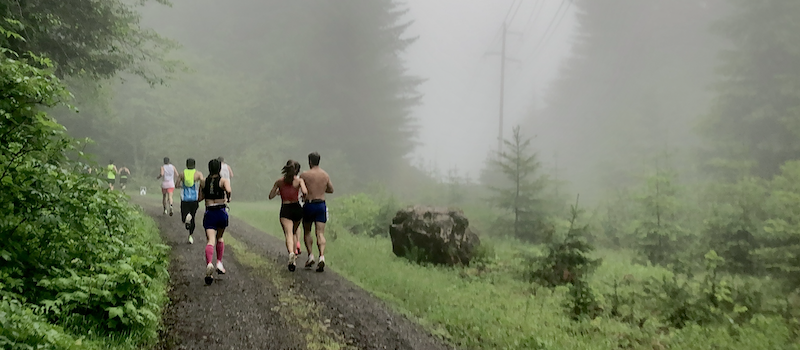
The gravel surface felt quite good under my shoes. It was not too rough and not too soft; in fact it seemed like it provided a bit of extra cushion compared to asphalt. The trail was wet, but even enough so that no big puddles had formed. The whole course had an average downhill grade of roughly 2%. That sounds like not much but for everyone who runs may agree that this is most likely some kind of a sweet spot: steep enough to have a sensation of “wow, I feel light today”, but flat enough to not feel a constant, uncomfortable pounding in your knees, along with the urge to work against gravity. My heart rate was stable in the high 160s, which I knew I could sustain for a while; at the same time, my pace was closer to four minutes per kilometer. Nothing to worry about for now; no discomfort, no breathing issues, no upset stomach. The nature around me presented itself in the form of lusciously green forests on steep mountain slopes shrouded in fog, through which the former railway tracks winded its way down between the invisible hill tops.
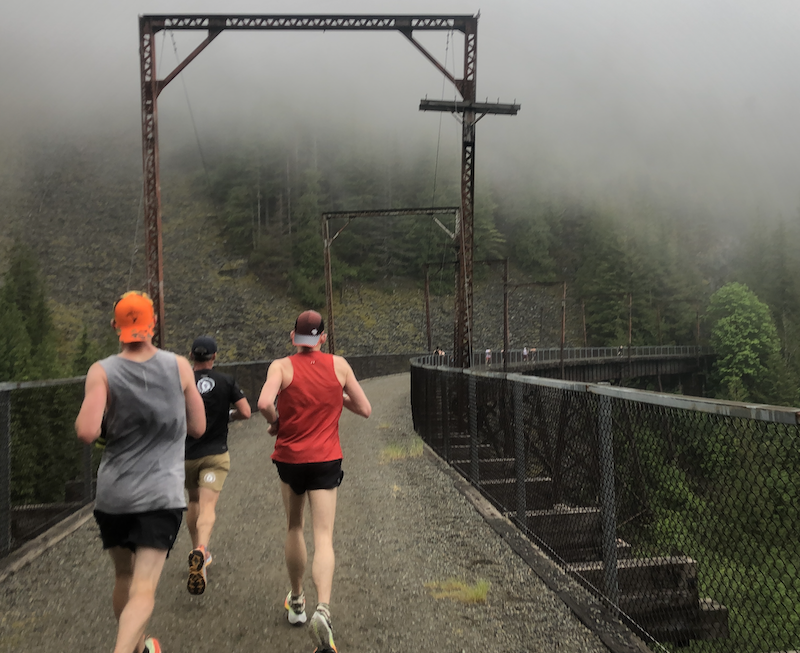
10k down, halfway done
Those first ten kilometers were truly enjoyable. Fast, too: just above 41 minutes for the first quarter of the race. Being fast at this point of a long-distance event does not mean anything but given that there have been runs during which I felt much worse even earlier provides some confidence. I just decided to keep going. If my heart rate wouldn’t go up, and my legs felt good, there was no reason to slow down.
With 800 runners in the field there were enough participants to never feel lonely, but it did not feel crowded either. After the first hour or so everyone seemed to have found their tempo and not too much passing was going on. There were no spectators on the course except for the short stretches around the water stations about every 4 kilometers. Occasionally the course would cross a road where some athlete’s families would be waiting for their runner to cheer on, but other than that it was just the gravel path, and a handful runners around your own thoughts.
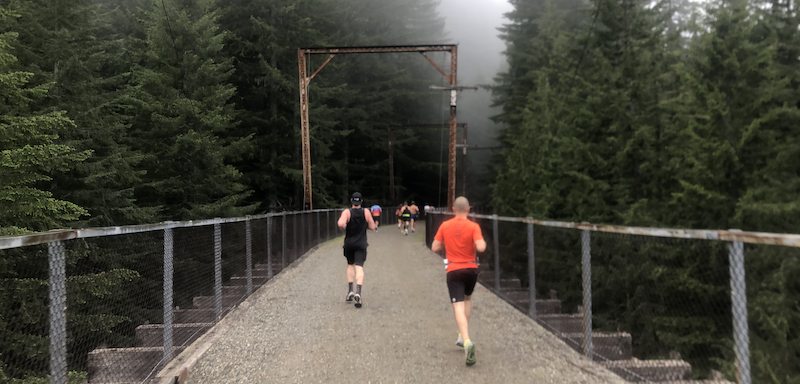
When I hit the half marathon mark in well under 90 minutes, I realized that I’d been running with the sub-3-hours group of people. This was way above my potential, and I wasn’t sure if I should be happy or worried about that. I still felt exceptionally well, had enough water on my bag and my stomach was taking the calories without any issues, too. If anything, I gained more and more confidence about finishing in a personal best time, even if I’d had to slow down at some point. So why not enjoying the flow, and the views along the small little railway bridges that we were crossing quite frequently.
The expected sufferfest
It was at kilometer 32 when it started to become harder very quickly. Within only 5-10 minutes my quads began feeling super tight, followed by increasing pain throughout the whole muscle. I had not felt that type of pain before and it was clearly caused by running a constant downhill grade for now more than two full hours. Ten more kilometers to go. My pace dropped considerable to now 4:40 per kilometer and all I could think about from now on were my quads. It all became a really painful slog surprisingly quickly. My confidence slowly swept away but I was able to keep pushing. At this point you count every single kilometer. I knew this would happen, and I even was happy that it did not happen earlier; but there were still 45 minutes of running to do and I couldn’t imagine the muscles to become anything than worse. After all, I was still going downhill, and I was still moving relatively fast.
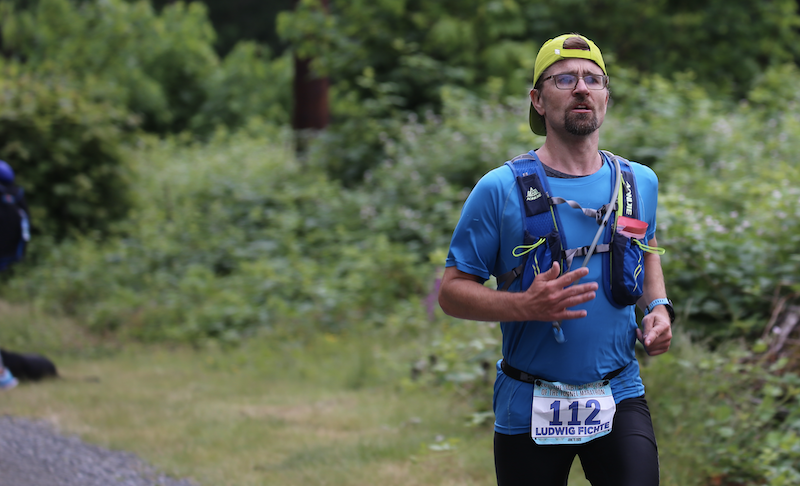
When I had four kilometers to go it became almost unbearable; all I hoped now was that my legs would not seize up completely, or my quads start cramping. Every single step felt like it could be the last one for today and I seriously started imagining not being able to finish at all just because my legs wouldn’t be able to carry me anymore. My heart and lungs were doing fine, heart rate in the low 170s, and I did not feel like I was lacking energy, but those quads! All I told myself was that I would not allow my legs to stop intentionally but would keep going until the muscles would take their own decision.
Boston qualified!
The route got flatter, it suddenly felt like uphill running, and a couple turns were yet to conquer but I already could hear the finish line in the distance. As so many times before, the final two kilometers were the hardest, but seeing end of the course in front of you is just the greatest relief ever; my legs were too damaged to pick up the pace, but when I saw the race timer in the distance still being under 3h5m I got that early endorphin rush that carried me over that long anticipated finish line.
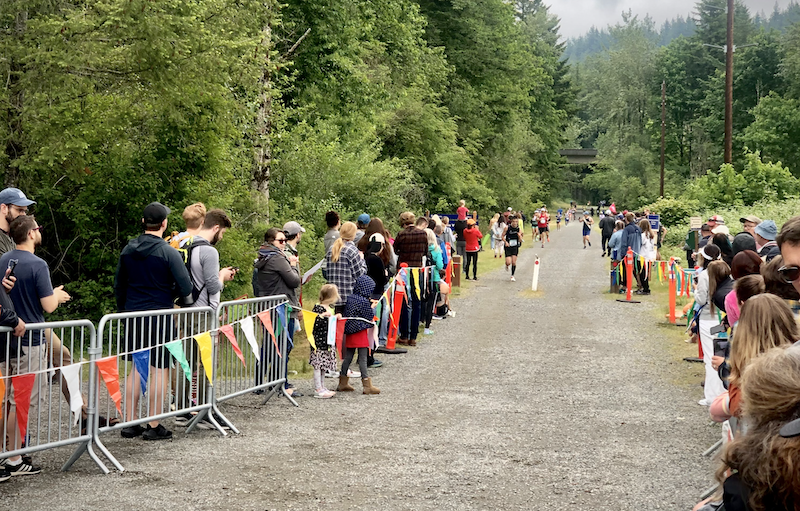
Official time: 3:04:44. Beating my age group’s Boston qualifying standard by more than five full minutes. I could hardly believe it myself and sat down on the next available chair just after receiving a pretty cool looking medal. That post race feeling just after finishing is very hard to describe to people who don’t run, and those who do exactly know what I’m talking about.
The day got even better when I saw Tara coming down the home stretch, still running, still looking strong. I was worried what the downhill profile would do to her own legs and then so happy seeing her crossing the final timing mat well below her own BQ standard of 3h30m. What an incredibly exhausting yet successful morning! This is a race to repeat someday and to recommend to anyone who likes running through nature in the mountains.
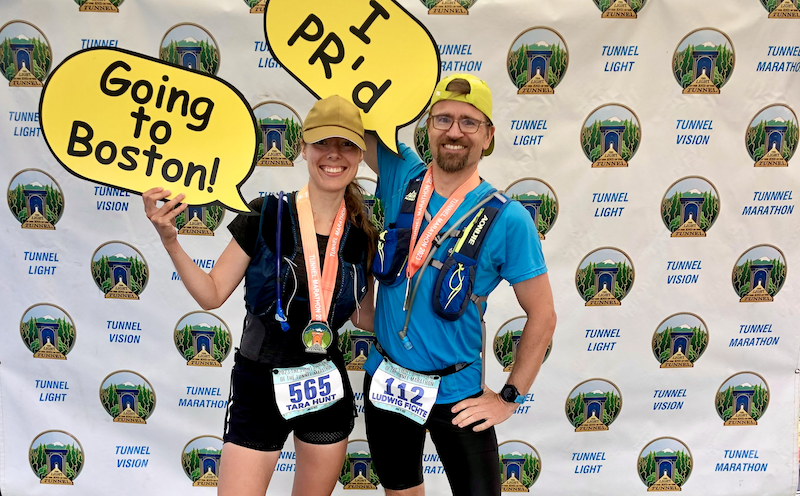
Nachbetrachtung
- Once again, I learned: a marathon only starts after 32 kilometers. No matter how good you feel at the halfway point, a lot can change within another hour.
- I think I figured out my nutrition game for marathons, which took me a couple of years. 700 calories of Tailwind diluted in 1500-1800ml of water in a hydration bladder works pretty well. Depending on the course and conditions, I’ll throw in a couple of gels or bars, and will add extra sips of water at each water station during the second half.
- Downhill running is a very tough game; it feels weightless at first, but within just a couple of kilometers later in the race your quads burn like hell. Very hard to train for, too.
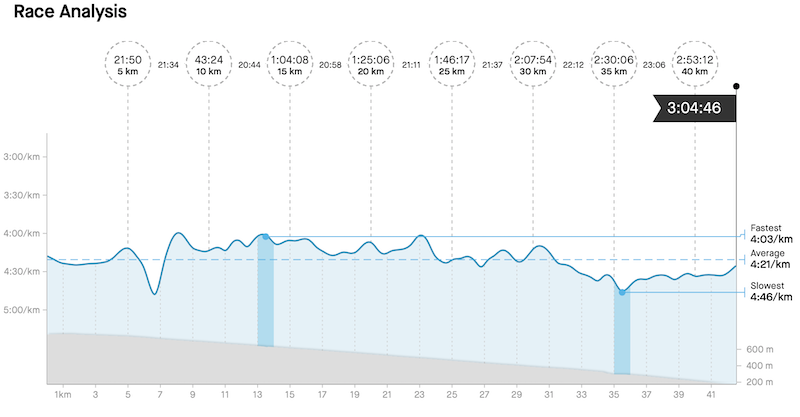
P.S.
It was a couple months later when the Boston Marathon applications for 2024 finally closed that we found out about this year’s cut-off times: 5m29s need to be substracted from the qualifying standard for anyone to qualify. This is due to the high number of applicants this year – more people made the standard than there were marathon slots available. My finish time was just a couple of seconds away from that cut-off and Tara missed it by just a minute or two. Somewhat of a disappointment at first but we’ll try again soon!
Statistiken
Gesamtstrecke: 42.2km
Gesamtzeit: 3:04:44
Herzfrequenz: 170bpm
Gesamte Höhe: -600m
Verbrannte Kalorien: 2650
Konsumierte Kalorien: 900
Flüssigkeit aufgenommen: 1800ml
Light at the End of the Tunnel Marathon North Bend, WA, USA | |||
Overall rating | |||
 | 2023 |  | 800 |
 | Summer |  | Punkt-zu-Punkt |
 | 7:00AM |  | Downhill (-700m) |
 | 9ºC |  | Gravel |
Individual ratings* | |||
Spectators | Scenery & views | ||
On-course nutrition | Overall organization | ||
Medal design | Finisher shirt | ||
Timing and splits | Value | ||
What stood out First couple of kilometers through a pitch-black tunnel is really special and ads a bit of complexity to your pacing plan. The post-race food was pretty good! Very little spectators throughout the course almost entirely through nature. | |||
*Einzelne Bewertungen: Details siehe unten
Die Bewertungen sind sehr subjektiv sind und basieren nur auf dem letzten Lauf, den ich persönlich durchgeführt habe. Einige Dinge wie das Design der Medaille oder des Finisher-Shirts können von Jahr zu Jahr stark schwanken.
Zuschauer: Wie viele Zuschauer entlang der Strecke? Wie viel Action und willkommene mentale Ablenkung für die Läufer, insbesondere in der zweiten Hälfte der Strecke, wurde geboten? Höhere Bewertungen für mehr Zuschauer, Action, Musik, etc.
Strecken-Verpflegung: Anzahl der Wasserstationen und Vielfalt des Nahrungsangebots.
Medaillen-Design: Wichtige Aspekte für mich: Spiegelt die Medaille in gewisser Weise den Ort oder die Strecke wider? Zeigt sie die Distanz und das Datum der Veranstaltung? Hat sie eine angemessene Größe und Form? Wie kreativ ist das Design? Sieht sie billig aus?
Zeitmessung: Wie viele Zeitmessmatten gab es auf der Strecke? Gab es Zeitmessungsmatten in Schlüsselbereichen, um Abkürzungen zu verhindern und Zeitsplits zu ermöglichen?
Umgebung/Aussicht: Wie viel visuelle Ablenkung und Staunen bekommt man als Läufer auf der Strecke? Normalerweise bieten Ein-Runden- oder Punkt-zu-Punkt-Läufe mehr Abwechslung im Vergleich zu Strecken mit mehreren Schleifen. Ich schätze natürliche Landschaften mehr als Industrie- oder Vorstadtgebiete.
Organisation insgesamt: Wie gut war die Veranstaltung insgesamt organisiert? Inklusive Kommunikation vor und nach dem Event, verfügbare Streckeninformationen, Expo, Neben-Events, Ansagen vor und nach dem Rennen, Start- und Zielbereich, usw.
Finisher-Shirt: Das Design des Shirts, die Art des Stoffes, ist es voll von Sponsoren?
Wertigkeit: Was man bekommt gegenüber dem was man bezahlt hat. Manche Rennen sind super teuer und man bekommt nicht einmal ein T-Shirt, andere sind preiswert und beinhalten sogar eine Pasta-Party am Vortag. Hohe Bewertungen bedeuten entweder billigen Eintritt oder viele Goodies.

